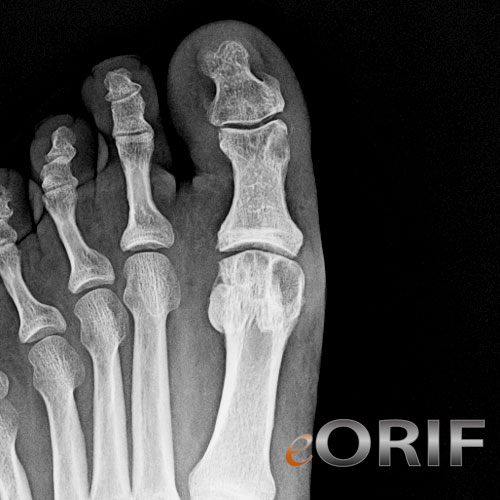 |
synonyms:
Gout ICD-10
- M10.00 - Idiopathic gout, unspecified site
- M10.011 - Idiopathic gout, right shoulder
- M10.012 - Idiopathic gout, left shoulder
- M10.019 - Idiopathic gout, unspecified shoulder
- M10.021 - Idiopathic gout, right elbow
- M10.022 - Idiopathic gout, left elbow
- M10.029 - Idiopathic gout, unspecified elbow
- M10.031 - Idiopathic gout, right wrist
- M10.032 - Idiopathic gout, left wrist
- M10.039 - Idiopathic gout, unspecified wrist
- M10.041 - Idiopathic gout, right hand
- M10.042 - Idiopathic gout, left hand
- M10.049 - Idiopathic gout, unspecified hand
- M10.051 - Idiopathic gout, right hip
- M10.052 - Idiopathic gout, left hip
- M10.059 - Idiopathic gout, unspecified hip
- M10.061 - Idiopathic gout, right knee
- M10.062 - Idiopathic gout, left knee
- M10.069 - Idiopathic gout, unspecified knee
- M10.071 - Idiopathic gout, right ankle and foot
- M10.072 - Idiopathic gout, left ankle and foot
- M10.079 - Idiopathic gout, unspecified ankle and foot
- M10.08 - Idiopathic gout, vertebrae
- M10.09 - Idiopathic gout, multiple sites
Gout ICD-9
Gout Etiology / Epidemiology / Natural History
- Men > female (20:1)
- Associated with hyperuricemia (serum urate >7mg/dl), genetic predisposition, acohol use, lead toxicity.
- Caused by monosodium urate crystal disposition in joints (strongly negative needle-shaped crystals).
- Tophi = deposits of monosodium urate crystals in soft tissues.
- 1 Beer daily increases uric acid levels by 0.4mg/dl and increases the incidence of Gout.
- crystalline depostion diseases
- abnormal purine metabolism=precipitation/deposition of monosodium urate crystals in synovial lined joints
- inciting factors: meds that increase serum uric acid, localized trauma, alcohol, purine-rich foods, postsurgical state
Gout Anatomy
- May affect any joint: great toe MTP joint, sternoclavicular joint, knee, etc
Gout Clinical Evaluation
- Acute severe pain in a single joint without antecedent trauma.
- First attack generally occurs in 40-50 y/o's.
- Most common presentation: monarticular lower extremity (1st MTP joint, ankle, knee) pain, warmth, tenderness, erythema.
- Fever, leukocytosis and elevated ESR are common.
- usually clinical diagnosis based on PE & hx
- needle-shaped monosodium urate crystals which are strongly negatively birefringent under polarized light.
- serum uric acid may or may not be elevated
Gout Xray / Diagnositc Tests
- Xrays: generally normal in early disease or first acute attack. Chronic cases demonstrate soft tissue tophi with calcifications, cortical erosions with sharply defined overhanging edges and sclerotic margins, relative preservation of joint spaces and normal bone density.
- Joint aspiration: Fluid sent for cell count, gram stain and cultures. Crystals are strongly negatively birefringent needle shaped under polarized light.
- characteristic radiolucent periarticular erosions, inoridinate soft-tissue enlargement
- Chronic=large deposits of gouty tophi, extensive articular and periarticular destruction
Gout Classification / Treatment
- Stage: asymptomatic hyperuricemia, acute gouty arthritis, intercritical gout, chronic tophaceous gout.
- Colchicine: affective in acute attacks
- Indomethacine: affective in acute attacks
- Consider corticosteroid injection once septic arthritis has been ruled out.
- Long term treatment: consider allopurinal to limit hyperuricemia
- Vitamin C 500mg QD may reduce serum uric acid levels by 0.6mg/dL (Gao, X, J Rheumatology 2008:35:1853).
- chronic = arthrodesis or gouty tophi removal
Gout Associated Injuries / Differential Diagnosis
Gout Complications
- Infection
- Painful arthritis
- Recurrent gouty attack
Gout Follow-up Care
- As acute attack subsides, desquamation of the overlying skin may occur.
- Tophi = soft-tissue masses caused by urate crystal deposition which may occur years after gout develops. Frequent locations: olecranon bursa, extensor surface of the forearm, Achilles tendon, hand tendon sheaths.
Gout Review References
- Griffin LY, Essentials of Musculoskeletal Care 3rd edition, AAOS, 2005
|

